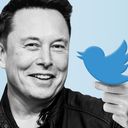How Musk's Twitter takeover came to pass

In 2020, Twitter (now called X) devised a three-year business plan whose internal goals were extremely aggressive, in order to placate activist investor Elliott Management. That spelled the beginning of then-CEO Jack Dorsey's eventual exit, reveals a new book, "Battle for the Bird," by Bloomberg's Kurt Wagner.
Why it matters: Elon Musk's takeover of the social media company seemed sudden in 2022, but Wagner argues that a set of events and circumstances set the stage for the deal.
- "Jack has since said [the Elliott Management entanglement] was the moment he decided to leave the company," says Wagner.
- And more importantly: "It's hard to believe that Elon would have done what he did if Jack had been there — you wouldn't really want to take a company from a founder," he adds.
The big picture: The book theorizes that the combination of Dorsey's disillusionment with the company and its board — coupled with his growing respect for Musk — set the stage for the takeover.
- In 2020, Dorsey invited Musk to speak at the company's retreat for executives, where he spoke effusively about the Tesla CEO. A foreshadowing of things to come: Musk complained at the time about Twitter's bot problem during that visit, according to the book.
Between the lines: By early 2022, Dorsey had stepped down, replaced by Parag Agrawal. And Musk had set his sights on Twitter for a number of reasons.
- According to Wagner, he had very unique annoyances with the service: a proliferation of never-ending bots and the @ElonJet account broadcasting his private jet's trips. He reportedly unsuccessfully asked Agrawal in January 2022 to remove the account, and began buying Twitter shares shortly after.
- Issues he perceived as stifling free speech also caught his eye.
The intrigue: Another surprise in the book is Project Saturn, Agrawal's quiet plan to to overhaul Twitter's content moderation — notably, in a "pro-speech" direction that likely would have been to Musk's liking.
- "[Dorsey and Agrawal] were both fans of trying to use the product to fix Twitter's speech issues, instead of more rules," says Wagner.
- Yes, but: Musk fired Agrawal immediately after taking over.
Our thought bubble: Wagner's book is a good read for those new to the saga, and want to get a sense of what led to one of the highest-profile M&A battles to grace the Delaware Chancery Court.
- But much to my chagrin, it doesn't get to the bottom of what prompted Musk to decide at the eleventh hour to go ahead with the deal after trying to back out. I guess we may never find out.
The bottom line: "One of Dorsey's biggest issues with Twitter was that it had too much power. ... Now X still has that power, but it is controlled by a single person: the richest man in the world," concludes Wagner.
- "The power that Dorsey so worried about has only been further centralized."